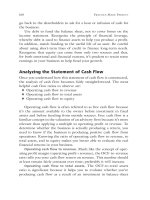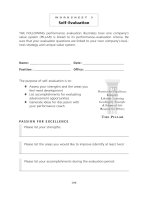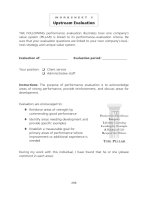Practice investment managerment pim3 ch01
Bạn đang xem bản rút gọn của tài liệu. Xem và tải ngay bản đầy đủ của tài liệu tại đây (355.06 KB, 14 trang )
Practical Investment Management
by
Robert A. Strong
University of Maine
PowerPoint Presentation
by
Yee-Tien Fu
National Cheng-Chi University
Taipei, Taiwan
South-Western / Thomson Learning © 2004
CHAPTER ONE
THE CONCEPT OF INVESTING
Practical Investment Management
Robert A. Strong
Outline
Investing Defined
Investment Alternatives
Assets
Securities
Security Groupings
Three Reasons for Investing
Income
Appreciation
Excitement
Thomson Learning/ South-Western © 2004
1-3
Outline
The Academic Study of Investments
Theoretical Research
Empirical Research
Professors vs. Practitioners
Thomson Learning/ South-Western © 2004
1-4
Investing Defined
To consume, to save, or to invest
a dollar that is earned ?
Both saving and investing amount to
consumption shifting through time.
However, saving involves little, if any,
risk, while investing is a risky
endeavor.
Thomson Learning/ South-Western © 2004
1-5
Investment Alternatives
Assets are things that people own.
Financial assets have a
corresponding liability, while real
assets do not.
Assets
Financial Assets
e.g. bond, stock
Thomson Learning/ South-Western © 2004
Real Assets
e.g. land
1-6
Investment Alternatives
A security is a legal document that
shows an ownership interest.
Although securities are historically
associated with financial assets, they are
also applicable to real assets.
Securitization is the process of converting an
asset or collection of assets into a more
marketable form.
Thomson Learning/ South-Western © 2004
1-7
Investment Alternatives
There are three broad categories of securities.
Securities
Equity
Securities
e.g. common
stock
Fixed Income
Securities
e.g. bonds,
preferred stock
Thomson Learning/ South-Western © 2004
Derivative
Assets
e.g. futures,
options
1-8
Three Reasons for Investing
Why invest ???
People invest to …
supplement their income
earn capital gains
Appreciation refers to an increase in the value of
an investment.
experience the excitement of the investment
process
Thomson Learning/ South-Western © 2004
1-9
The Academic Study of Investments
Theoretical research involves
building mathematical models and
proposing pricing relationships
rather than studying actual market
data.
E.g. arbitrage relationships, impact of stock
splits and cash dividends on investors
Theoretical models are frequently tested by
conducting empirical research.
Thomson Learning/ South-Western © 2004
1 - 10
The Academic Study of Investments
Empirical research uses actual market data
rather than mathematical models.
An anomaly is an observed result that defies
explanation within the known theoretical
framework.
Thomson Learning/ South-Western © 2004
1 - 11
The Academic Study of Investments
vs.
Professors
Practitioners
The investment community can learn much
from both rigorous academic research and
from the life experiences of people on the
front lines of the marketplace.
Thomson Learning/ South-Western © 2004
1 - 12
Review
Investing Defined
Investment Alternatives
Assets
Securities
Security Groupings
Three Reasons for Investing
Income
Appreciation
Excitement
Thomson Learning/ South-Western © 2004
1 - 13
Review
The Academic Study of Investments
Theoretical Research
Empirical Research
Professors vs. Practitioners
Thomson Learning/ South-Western © 2004
1 - 14









